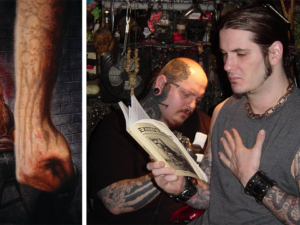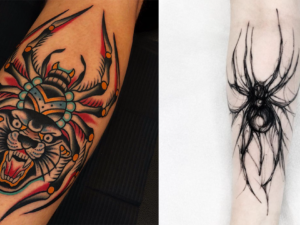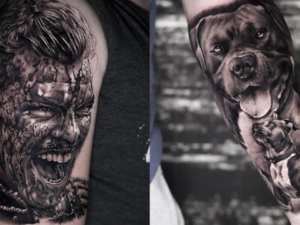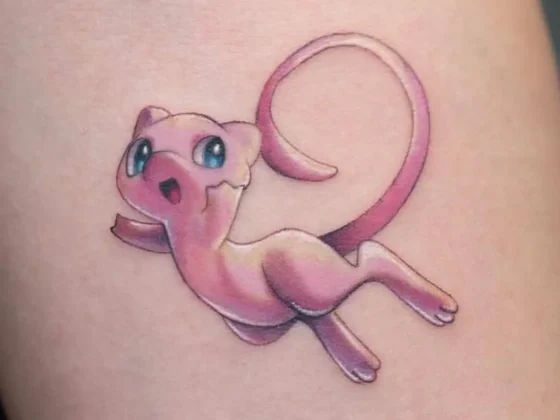Inked Mag
December 21st, 2018
4 Year Anniversary Since New York Bans Pet Tattooing
Tattoos can potentially cause pain and infection to dogs, but animal-rights organizations like PETA, support pet tattoos for tracking your four-legged friends.
As tattoos can potentially cause pain and infection to dogs, you can be jailed for animal abuse. However, shelters and animal-rights organizations like PETA, support pet tattoos for tracking your four-legged friends.

At this time 4 years ago, New York State made it illegal to tattoo or pierce your pets. While the controversial act had received backlash from animal-rights enthusiasts, there are important arguments that defend against the “animal abuse” picket signs.
New York had created the legislation, after the viral out-cry from a North Carolina man’s post.
Tattoo artist Ernesto Rodriguez inked the bellies of his two pitbulls, Duke and Duchess. He said he did this so they could be easily identified if they were to run away, or become lost.

“They both have their tattoos on them just in case anything happens to them,” Rodriguez said.
While pet tattoos are a valid way to identify your four-legged friend, many people were outraged that Rodriguez took the idea of the identification number tattoo too far.

“My opinion is that if you want to mark your dog you don’t have to do it so large. The skin on a dog’s stomach is thin and will be more painful for the healing process. Nothing wrong with a small marking but a large one is a little much,” Jennifer L. Ward wrote.
Kristine Lacoste added, “It’s a pretty big tattoo; seems overboard for just identification purposes, doesn’t it?”

Rodriguez posted a photo of the job on his Facebook page captioning it: “Animal control came, looked at my beautiful dogs and left…. wow… what a waste of taxpayers money… so im still gonna tattoo my dogs whenever i feel like it… good try haters thanks for all the advertisement.”

Rodriguez said the animals were sedated when the tattoos were applied.
“It’s just art; I’m an artist, I want to put art on my dogs,” he said.
However, controversy does not come without support.
Cheri Iverson commented that her pets have tattoos applied at local spay-and-neuter clinics.
“I just wish their tattoos were this creative,” Iverson wrote.

PETA advocates for pet tattoos for tracking and identifying
The controversy furthers, especially as The National Dog Registry and PETA (People for the Ethical Treatment of Animals) are inadvertently in support of Rodriquez.
The National Dog Registry (NDR) had advocated that animal owners tattoo their dogs and cats to protect them from pet theft. While the page is no longer up, the webpage that included information in defense of the pet tattoo practice was titled: www.nationaldogregistry.com/whytat.html

According to PETA’s page, shelters and adopting families sometimes choose to use tattoos as a safeguard against dogs getting lost. The website says:
“To make doubly sure that their animals are returned if lost or stolen, many caretakers also have their animals tattooed on their inner thigh with an identification number — such as their social security number — in their veterinarian’s office or at a tattoo clinic,” the website said. “Unlike microchips, tattoos are visible (as long as the hair over the tattoo is thin or kept shaved or clipped short) and more noticeable to a person or animal shelter that may not have microchip scanning capabilities or knowledge of scanning technology.”

MyPetsDoctor.com still keeps the mention of minimalist tattoo on their site, reasoning that small lines can signify surgical status of a shelter pet. The MyPetsDoctor page says: “Veterinarians use small, straight-line tattoos when pets are spayed or neutered to let future caregivers know that this particular pet no longer has internal reproductive organs.”
Even to someone against pet tattooing, this makes sense. If a dog’s surgery healed so well that no surgical scars are visible, someone may not be able to tell if a dog had been fixed. The tattoos would then prevent exploratory abdominal surgery.

If shelters and vets are tattooing dogs, shouldn’t it be okay for tattoo artists?
With pet tattooing being an acceptable form of identification for animals, and especially that it is backed up by PETA, why wouldn’t a certified tattoo artist be able to tattoo their own pets?

The NDR suggested that pet tattooing might not stop at a small unique number sequence. Thus, insert Ernesto Rodriguez. But Rodriguez isn’t the only one to have done this, let alone receive backlash.
Brooklyn tattoo artist, Mistah Metro, had to bring his dog to the vet to have her spleen removed. The vet allowed Metro to tattoo a classic tattoo-style heart with an arrow on the dog’s shoulder. Metro then bragged on Instagram that his “dog is cooler than yours.”

At this time, the ASPCA and PETA spoke up about the impropriety of elaborate tattoos on dogs.
“The tattooing of an animal for the selfish joy and entertainment of its owner — without any regard for the well-being of the animal — is not something the ASPCA supports. The incident in question is not at all comparable to the practice of leaving a small mark on an animal for identification purposes following spay or neuter surgery,” insisted Aimee Christian, then-vice president of spay/neuter operations at the ASPCA.
“This tagging procedure, performed by a licensed veterinarian or veterinary technician while the animal is under anesthesia, helps animal welfare professionals clearly identify animals that have been altered, preventing unnecessary future surgeries.”

Are tattoos as painful for them?
However, Metro said that his dog was still under anesthesia, and wouldn’t have felt any pain. Actually, How Stuff Works explained that: “Pets don’t need to be under general anaesthetic to get tattooed.” The page said, “Pet tattoos are not as deep as those a human would normally have done, which is why there is no bleeding and the procedure is painless.”
The Metro and Rodriguez cases led to the laws prohibiting pet piercings or pet tattoos in both New York and New Jersey—with exceptions for ink done by veterinarians or rescue organizations for medical or identification purposes. But it brings up the question: Who gets to decide how much and what ink is inhumane for a dog?

If rescue organizations and veterinarians have the “go ahead” to tattoo pets, it calls for people to feel justified in tattooing their pets as well.
Assembly member Linda Rosenthal sponsored the legislation, signed by New York state’s Governor Andrew Cuomo.

Rosenthal said, “It’s simply cruel,” adding that animals do not have the ability to choose the pain that comes with a tattoo.
The law does make exceptions for markings made for identification or medical reasons, but those only include pre approved letters and numbers.
Other than that, the governor’s office says, piercing your pooch could now get you up to 15 days in jail or $250 in fines.

Editor's Picks
Paul Booth Illustrates Cover for Pantera Graphic Novel
The revered tattoo artist created a cover for a graphic novel celebrating the 30th anniversary of “Vulgar Display of Power”
Scary Spider Tattoos
Spiders are terrifying, yet for some reason people sure do love to get tattoos of them














